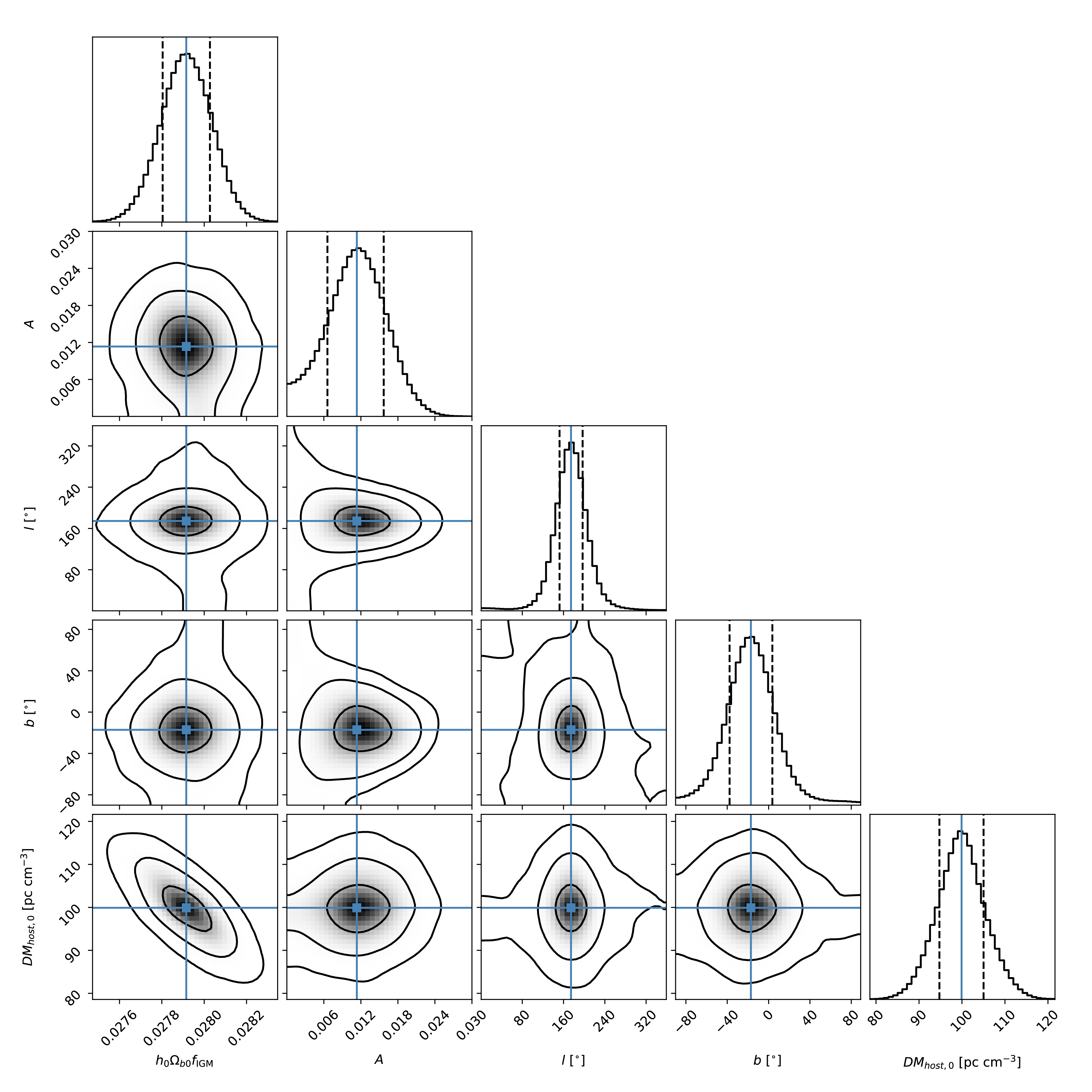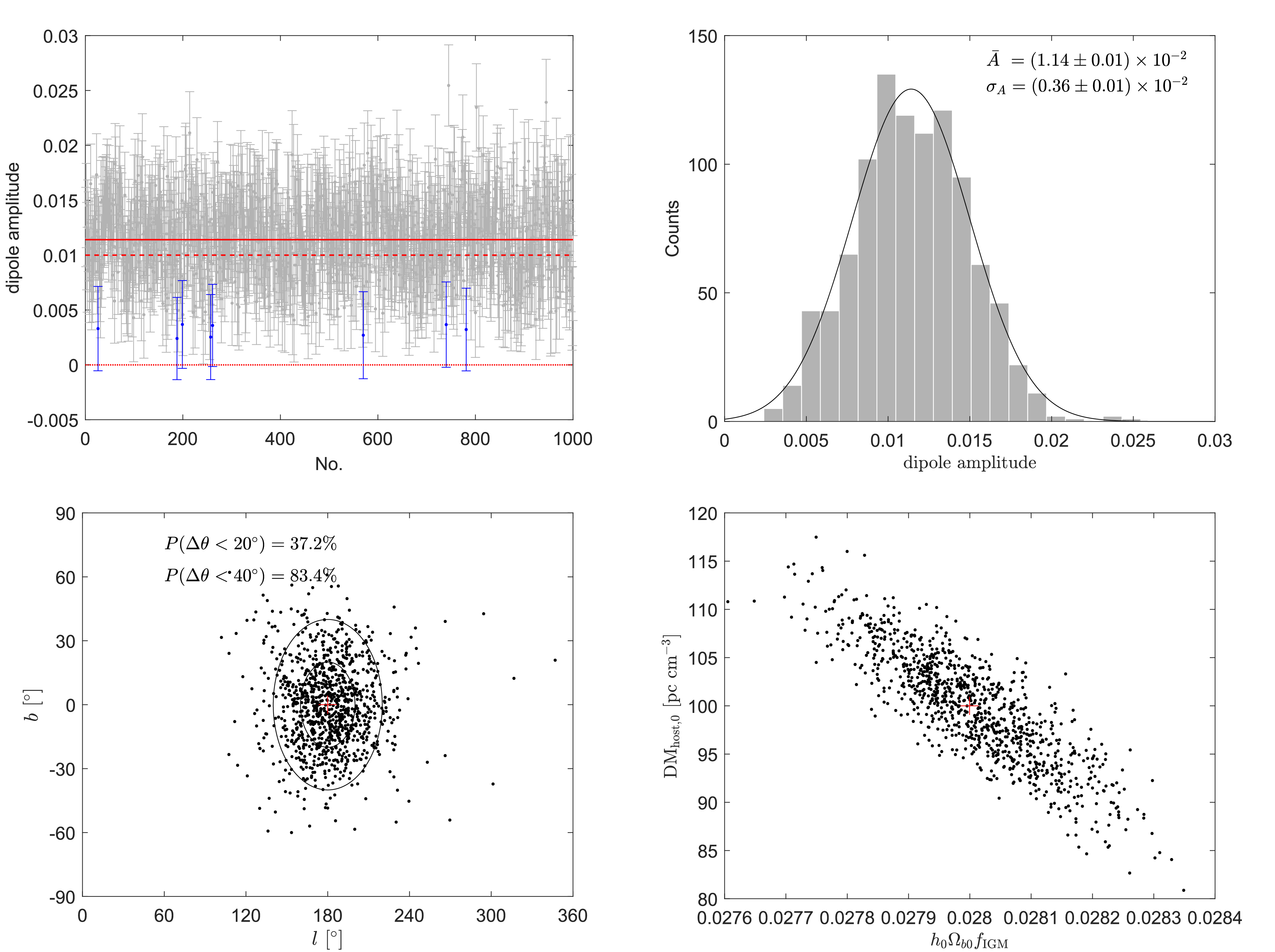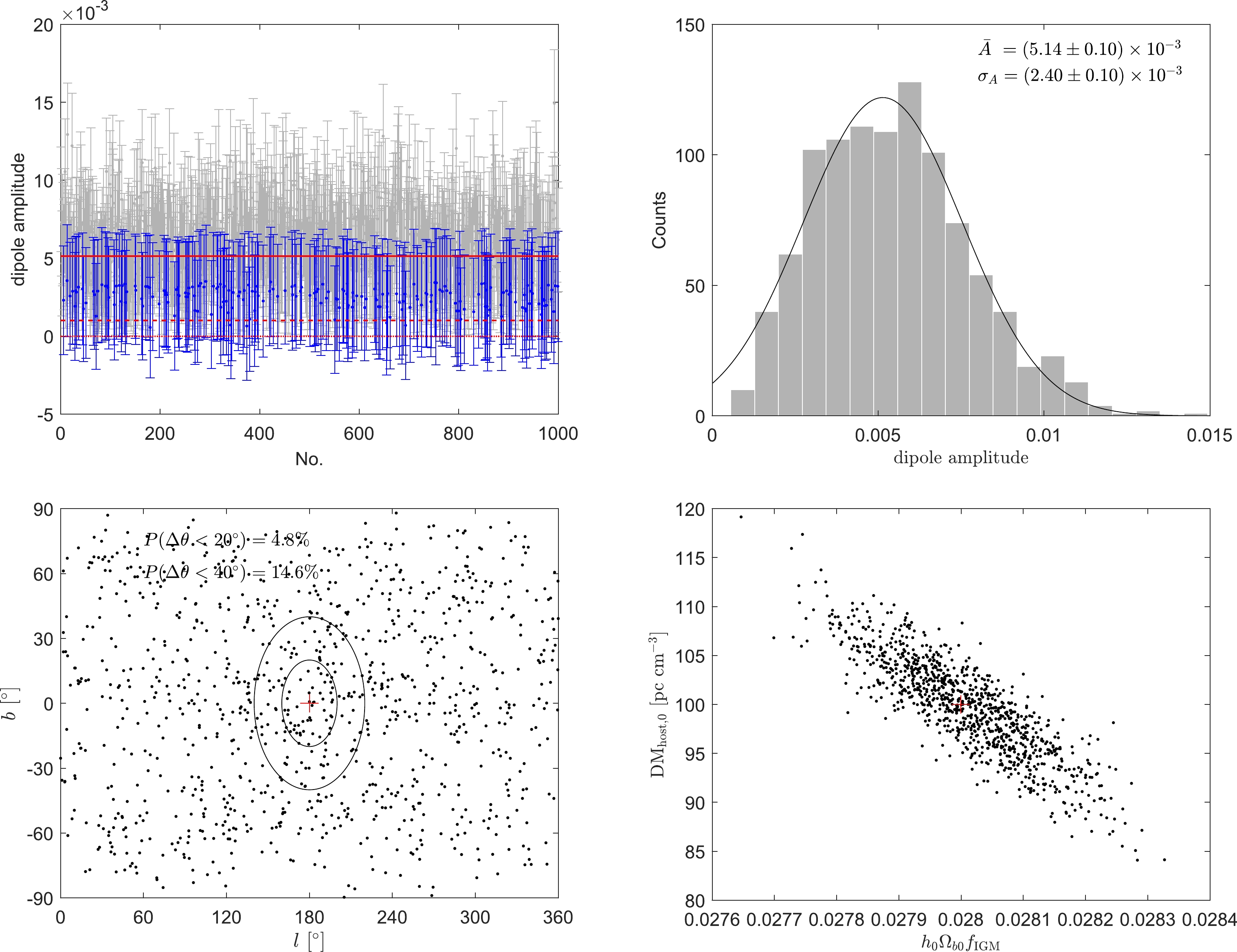HTML
--> --> -->FRBs are very energetic and detectable up to a high redshift [20]; therefore, they can be used as instruments to study cosmology. Yu & Wang showed that FRBs can be used to measure the cosmic proper distance [21]. Walters et al. showed that FRBs can constrain cosmological parameters, especially the baryon matter density [22]. Li et al. proposed that FRBs can be used to independently constrain the fraction of baryon mass in the intergalactic medium (IGM) model [23, 24]. Xu & Zhang proposed that FRBs can be used to probe intergalactic turbulence [25]. Wu et al. pointed out that FRBs can aid in measuring the Hubble parameter
Observations of the cosmic microwave background (CMB) show that the Universe is homogeneous and isotropic on a large scale [36, 37]. However, there is no direct evidence that the baryon matter is also isotropic, and observations of the luminosity of type-Ia supernovae show that there is possible anisotropy [38-40]. In addition, observations of the fine-structure constant from quasar absorption lines show that the Universe may be anisotropic [41, 42]. Interestingly, the dipole fitting of both the supernovae data and fine-structure constant data leads to a consistent dipole direction [43], and this anisotropy can be caused by, for example, the interaction of photons with the anisotropic distribution of baryon matter. In this paper, we will show that FRBs can be used to test the possible anisotropic distribution of baryon matter in the Universe. The DM is the integral of electron density along the line of sight, while the latter is proportional to the baryon matter in the Universe. By measuring the DM of hundreds of FRBs in different directions in the sky, we can detect the anisotropic signal in the baryon matter distribution.
The rest of this paper is arranged as follows: In Section II, we present the methodology for testing the anisotropic distribution of baryon matter using FRBs. In Section III, we investigate the capability of future FRB data to test the anisotropic distribution of baryon matters using Monte Carlo simulations. Finally, discussions and conclusions are presented in Section IV.
In general, the observed DM of an FRB contains three parts: the contributions from the Milky Way (MW), the intergalactic medium (IGM), and the host galaxy [45, 46],
$ {\rm DM_{obs}} = {\rm DM_{MW}}+{\rm DM_{IGM}}+\frac{{\rm DM_{host}}}{1+z}, $  | (1) |
$ {\rm DM_{\it E}}\equiv{\rm DM_{obs}}-{\rm DM_{MW}}. $  | (2) |
$ {\rm DM_{\it E}^{\rm th}} = {\rm DM_{IGM}}+\frac{{\rm DM_{host}}}{1+z}. $  | (3) |
The DM contribution from the IGM, assuming both hydrogen and helium are fully ionized (this is justified at
$ {\rm \overline{DM}_{IGM}}(z) = \frac{21cH_0\Omega_b f_{\rm IGM}}{64\pi Gm_p}\int_0^z\frac{1+z}{\sqrt{\Omega_m(1+z)^3+\Omega_\Lambda}}{\rm d}z, $  | (4) |
$ \Omega_b(\hat{\mathbf p}) = \Omega_{b0}(1+A{\hat{\mathbf n}}\cdot{\hat{\mathbf p}}), $  | (5) |
$ \begin{aligned}[b] {\rm \overline{DM}_{IGM}}({\hat{\mathbf p}},z) =& \frac{21cH_0\Omega_{b0}f_{\rm IGM}}{64\pi Gm_p}(1+A{\hat{\mathbf n}}\cdot{\hat{\mathbf p}}) \\ &\times\int_0^z\frac{1+z}{\sqrt{\Omega_m(1+z)^3+\Omega_\Lambda}}{\rm d}z, \end{aligned} $  | (6) |
$ {\rm \overline{DM}_{host}}(z) = {\rm DM_{host,0}}\sqrt{\frac{{\rm SFR}(z)}{{\rm SFR}(0)}}, $  | (7) |
$ {\rm SFR}(z) = 0.02\left[(1+z)^{a\eta}+\left(\frac{1+z}{B}\right)^{b\eta}+\left(\frac{1+z}{C}\right)^{c\eta}\right]^{1/\eta}, $  | (8) |
By fitting the observed
$ \chi^2 = \sum_{i = 1}^N\left[\frac{({\rm DM}_E-{{\rm DM}_E^{\rm th}})^2}{\sigma_{\rm total}^2}\right], $  | (9) |
$ \sigma_{\rm total} = \sqrt{\sigma_{\rm obs}^2+\sigma_{\rm MW}^2+\sigma_{\rm IGM}^2+\sigma_{\rm host}^2/(1+z)^2}. $  | (10) |
Due to poor knowledge of its physical mechanism and a lack of direct redshift measurements, the actual redshift distribution of the FRB is still unclear. Yu & Wang assumed that the redshift distribution of FRBs is similar to that of gamma-ray bursts [21], and Li et al. assumed that FRBs have a constant comoving number density, but with an exponential cut-off [23]. Here, we assume that the intrinsic event rate density of FRBs follows the SFR, where the redshift distribution of FRBs takes the form [53]
$ P(z)\propto\frac{4\pi D^2_c(z){\rm SFR}(z)}{(1+z)H(z)}, $  | (11) |
We simulated N FRBs, each containing the following parameters: the redshift z, the direction of FRB in the galactic coordinates
1. The redshift z is randomly sampled according to the probability density function given in equation (11). The upper limit of the redshift is set to
2. The sky direction
3. The fiducial and anisotropic
4. The fiducial values of
5. The extragalactic DM is calculated according to equation (3), and the total uncertainty
We simulated
 Figure1. (color online) The best-fit results in a typical simulation with
Figure1. (color online) The best-fit results in a typical simulation with Owing to statistical fluctuation, the best-fit parameters differ in each simulation. Therefore, we simulated 1000 times for each N with different random seeds. Figure 2 shows the results for
 Figure2. (color online) The best-fit parameters in 1000 simulations with
Figure2. (color online) The best-fit parameters in 1000 simulations with We performed similar calculations for different values of N, and the results are shown in Table 1. From this table, we can see that as N increases, the probability that we can detect the anisotropy,
| N |   |   |   |   |   |
| 100 | 0.862 | 0.093 | 0.329 | 1.86 | 0.86 |
| 200 | 0.904 | 0.141 | 0.449 | 1.51 | 0.67 |
| 300 | 0.933 | 0.198 | 0.567 | 1.34 | 0.53 |
| 400 | 0.953 | 0.234 | 0.638 | 1.25 | 0.50 |
| 500 | 0.968 | 0.272 | 0.685 | 1.19 | 0.44 |
| 600 | 0.979 | 0.293 | 0.744 | 1.17 | 0.41 |
| 700 | 0.985 | 0.355 | 0.794 | 1.17 | 0.39 |
| 800 | 0.992 | 0.372 | 0.834 | 1.14 | 0.36 |
| 900 | 0.996 | 0.388 | 0.854 | 1.12 | 0.34 |
| 1000 | 0.991 | 0.427 | 0.864 | 1.07 | 0.31 |
Table1.The results of 1000 simulations for different values of N. The fiducial parameters are
 Figure3. (color online) Left: the mean value of the dipole amplitudes in 1000 simulations as a function of N. The error bar represents the standard deviation of the dipole amplitudes. Right: the probability that we can correctly reproduce the fiducial dipole amplitude or dipole direction as a function of N.
Figure3. (color online) Left: the mean value of the dipole amplitudes in 1000 simulations as a function of N. The error bar represents the standard deviation of the dipole amplitudes. Right: the probability that we can correctly reproduce the fiducial dipole amplitude or dipole direction as a function of N.To investigate whether an increase in
To test if FRBs can probe a weaker anisotropic signal, we used a fiducial dipole amplitude
 Figure4. (color online) The same as Figure 2, but with
Figure4. (color online) The same as Figure 2, but with In a recent study, Qiang et al. used FRBs to test the anisotropy of the Universe with a similar simulation method, but found a very different result [28]. They discovered that about
The progenitors of FRBs are still unclear. The most popular models evolve one or two compact objects (such as neutron stars and magnetars) in the center of an FRB source [1]. FRBs are expected to be frequent events in the Universe, although some of them cannot be observed due to low luminosity. Based on the compact binary merger model, the event rate of FRBs is estimated to be approximately

